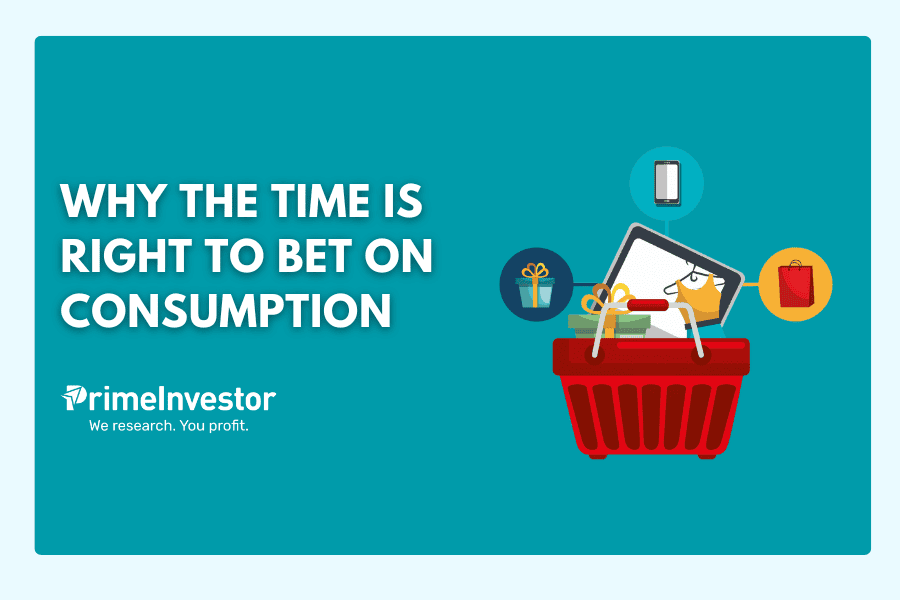The best time for equity investors to bet on a sector or a theme is when there’s a barrage of negative headlines about it, and market mavens predict gloom and doom for it. This is just one of the reasons why this is a good time to buy into the domestic consumption theme.

There has been a lot of negativity about consumption lately. This has stemmed from a few listed consumer companies from FMCG and paints reporting poor numbers in the September quarter and giving pessimistic commentary about food inflation and a shrinking middle class.
But companies will seldom admit to competition or disruption taking a toll on their business. Macro data shows that there is nothing structurally wrong with Indian consumption or the consumer currently.
In this report, we detail five reasons why this is just the right time to bet on the consumption theme.
#1 Private consumption is healthy
If you are a long-term equity investor, you need to be bullish about the prospects of the economy on which you are betting. In India, it is impossible to be bullish about the economy while being pessimistic about consumption.
Of the four components that make up the GDP of any country:
- household consumption (Private Final Consumption Expenditure or PFCE),
- government consumption (Government Final Consumption Expenditure or GFCE),
- capital investments (Gross Fixed Capital Formation or GFCF) and
- exports,
household consumption is by far the largest driver of India’s GDP and has been so for years. PFCE currently accounts for 62% of India’s real GDP. Therefore, if the economy is to sustain 6-7% growth, domestic consumption must grow at about this rate too.
CSO data moreover shows that PFCE will grow at a good rate this fiscal year. PFCE, which expanded at a 7% CAGR (in real terms) between FY10 and FY20, shrank by 5.3% in FY21 due to Covid, rebounded by 11.6% in FY22 and moderated in FY23 and FY24.
In FY25, as per first advance estimates of GDP, PFCE is set to return to 7.3% growth. PFCE in nominal terms is expected to grow at 12.4%. Therefore, while there may be some pockets of consumption or some listed companies facing a slowdown, there is nothing much wrong with domestic consumption or consumer confidence right now.
#2 The poor spend more, elite cut back
The market narrative has been that high food inflation is forcing consumers to tighten their belts and hurting consumption. While some listed companies have used this convenient ruse to explain their slowing sales, there is little hard evidence that inflation is hurting consumers so much that they are unable to spend on essentials.
This is precisely what the latest Household Consumption Expenditure Survey (HCES) conducted by the NSO shows. The HCES is one of the largest official consumption surveys in India. Once in every five years, NSO surveyors visits thousands of households across rural and urban India to collect data on their monthly consumption expenses to present the HCES. HCES findings are used to decide on the goods and services that will make up the CPI and to determine the base year for GDP.
After a long delay due to a change in government and Covid, the NSO recently conducted two consecutive HCES in August-July 2022-23 and August-July 2023-24, covering 2.61 lakh households across all States and Union Territories.
The latest HCES released in December 2024 shows that the per capita monthly expenditure of rural households in India grew by 9.2% to Rs 4122 in 2023-24, while that of urban households grew by 8.3%. In the preceding 11 years (2012 to 2023), rural consumption expenditure grew at 9.2% CAGR while urban consumption grew at 8.5% CAGR. This shows no meaningful consumption slowdown.
In fact, consumption seems to be growing strongly at the bottom of the pyramid. HCES’ break-down of monthly expenditure into population segments shows that the bottom 50% spenders have expanded their consumption by double digits in 2023-24, while the top layer has been cutting back. The table below shows that the bottom 5% spenders expanded their consumption the most in 2023-24. It is the top 5% who were cutting back.
Poorer households are more likely to feel the pinch of food inflation than the rich. Therefore, these trends suggest that it was not inflation that hurt consumption in some pockets, but tighter credit availability and high interest rates.
#3 Reviving agri fortunes
India’s agricultural fortunes are set to stage a significant revival this fiscal, after a sharp setback due to a long-staying El Nino in FY24. Agricultural GDP is set to expand y 3.8% in FY25 from growing just 1.4% in FY24. Nominal growth is expected to return to double digits.
Agriculture and allied services are still the main employment generators in rural India. Therefore, high food prices for a sustained period lift farm incomes and spur rural consumption. The Centre’s distribution of free foodgrains to over 80 crore Indians since Covid and the proliferation of cash transfer schemes from the States, has also added to the disposable incomes of rural and low-income folk and shielded them from the worst of food inflation in recent times.
With El Nino fading in September/October 2024, India received good rainfall in the latter part of the monsoon and post-monsoon period, leading to healthy rabi prospects. The NDA regime, after dialing down on outlays for agriculture in its first term has stepped up outlays towards MSPs, procurement, fertilizer and food subsidies and kisan credit in its second and third terms. Cash transfer schemes like PM Kisan now coexist with conventional procurement, fertilizer, power and credit subsidies. All this promises to translate into a strong pickup in rural consumption in the year ahead.
#4 Upcoming rate and Pay Commission kicker
Credit availability and interest rates are the key driver of discretionary consumption by higher income folks. Therefore, it is a positive for such consumption that we are the peak of the current interest rate cycle.
Right now, with a weak Rupee, foreign exchange outflows and suspense around Trump policies, there is uncertainty about when India’s MPC will act to actually cut rates. (Read our recent debt outlook to understand why rate cuts are delayed) It is also not clear if RBI will ease up on its retail credit restrictions imposed in November 2023.
But it is becoming increasingly clear that such measures are critical to reviving India’s GDP growth. The change of guard at RBI with a new Governor and MPC members taking over offers some hope that the ultra-tight monetary policy will give way to an easier regime more suited to a sluggish economy. Rate cuts, as and when they materialize, will provide a kicker to sales of vehicles and durables apart from spending on travel and services.
A year or two down the road, consumer companies can also look forward to a boost from government employees going on a spending binge, thanks to the 8th Pay Commission, which has just been constituted. Past pay commissions, which have pegged up government employees’ salaries by up to 25% have proved a booster to car, two-wheeler, and durable sales.
The NDA has just announced the constitution of the 8th Pay Commission. These recommendations are expected to prop up pay and benefits for over 1 crore government employees and pensioners. While the recommendations may be out only in late 2026 or 2027, markets are likely to build in the impact ahead of the event.
#5 Trump effect
Finally, the next couple of years promise to be volatile ones for global trade, with the impact of Trump’s disruptive trade policies likely to play out. Meanwhile, the domestic capex juggernaut is also expected to slow, given that the Centre is in fiscal consolidation mode and is finding it tough to even meet capex targets.
This rules out exports and GFCF as big drivers of India’s GDP growth, passing the baton to domestic consumption. This too is likely to drive sector rotation in the markets towards currently out-of-favour consumption stocks.
How to play it
At PrimeInvestor, our recommendations around the consumption theme are as follows:
- Mutual funds: Thematic funds are the best option for a clear consumption bet. Refer to the ‘Thematic’ section in Prime Funds for our fund recommendation here.
- Stocks: Our stock recommendations in Prime Stocks feature a few quality names from consumer goods and services – such as our recent call on this entertainment stock, our early bet on an FMCG stock, or our mass consumer pick. You can pick individual stocks from here. We’ll also be adding to these recommendations in the coming year.
- Stock portfolio: Apart from the above, we have a smallcase stock portfolio built on discretionary consumption – Prime Trends: Consumption. This smallcase has a very unique portfolio that has very few overlaps with thematic consumption funds. (You can use the coupon code PRIME10 for a 10% discount)







2 thoughts on “Why the time is right to bet on consumption”
What is recommendations on terms of lumosum vs sip investment
The reco is for lumpsum investment